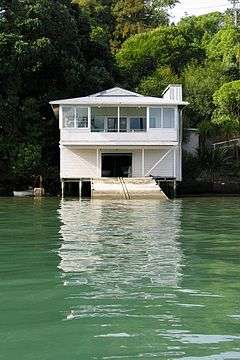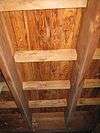Sea Scouts New Zealand
Sea Scouts New Zealand are part of the New Zealand Scouts Association. There are around 900 Sea Scouts in New Zealand in 53 troops around the country.[1]
| Sea Scouting | |||
|---|---|---|---|
| Country | New Zealand | ||
| Founded | 1909 | ||
| Founder | Warington Baden-Powell | ||
|
| |||
| Website http://www.scouts.org.nz/ABOUTUS/SeaScouts.aspx | |||
The New Zealand Sea Scouts use a 17-foot cutter as their principal boat – the concept of having a specific boat for Sea Scouts in New Zealand originated in 1944. The first two boats of this class were ready for the 1st National Dominion Regatta in 1945. The original boats were clinker built and used Kauri as the main timber. The rig was a gunter designed so that all the spars could be stowed inside the boat for towing. These wooden cutters are still in use today including the first built. They continued to be built in the original manner until the early 1970s; around 140 were built over this period. In the late 1960s and early 1970, fibreglass versions of the cutters began to be produced, the hull being identical in shape and size but the gunter rig was replaced with a Bermudan design using aluminium mast and boom. These boats are still in production and around 90 have been built.[2]
National regattas
National Sea Scout regattas take place every three years. The activities and competitions typically run for 9–10 days.[3] The Premier Award is the Jellicoe Trident which was present in 1924 by the Admiral of the Fleet, Viscount Jellicoe .[4][5] He was the second Governor General of New Zealand.

- 1924 Christchurch - Jellicoe Trident Award winners: Iron Duke Sea Scouts Nelson[4][6]
- 1930 Petone[7] - The runners up in the Jellicoe Trident Award were the "Irresistible" Sea Scout Group,
- 1945 Picton, New Zealand
- 1947 Tauranga – Jellicoe Trident Award winners: Takitimu Sea Scout Group, Gisborne tied[8]
- 1949 Nelson, New Zealand – Jellicoe Trident Award winners: Takitimu Sea Scout Group, Gisborne tied[8]
- 1951 Auckland (Motuihe Island) –
- 1953 Southland Region –
- 1955 Gisborne – Jellicoe Trident Award winners: Takitimu Sea Scout Group, Gisborne[9]
- 1957 Ngatitoa Domain, Paremata, Wellington –[10] Jellicoe Trident Award winners:Te Ara o Kiwa Sea Scouts, Southland
- 1959 Auckland –
- 1961 Akaroa –
- 1963 9th Dominion Regatta Auckland, Motutapu Island – Jellicoe Trident Award winners: Takitimu Sea Scout Group, Gisborne[11]
- 1965 Ngatitoa Domain, Paremata, Wellington –[12] Jellicoe Trident Award winners: Shackleton Sea Scout Group, Whangarei
- 1967 Lake Waihola, Dunedin – Jellicoe Trident Award winners: Iron Duke Sea Scouts Nelson
- 1969 Kaiapoi –
- 1971 Whangarei –
- 1973 Wellington–(14th National Regatta) Jellicoe Trident Award winners:St James Sea Scout Group, Petone, Lower Hutt[13][14]
- 1975 Tokoroa –
- 1977 Lake Waihola, Dunedin – Jellicoe Trident Award winners: Britannia Sea Scout Group, Evans Bay, Wellington
- 1979 Picton, New Zealand –
- 1981 Hastings, New Zealand –
- 1983 Auckland (Whangaparaoa Peninsula) – Jellicoe Trident Award Winners: Pegasus Sea Scout Group, South Brighton, Christchurch
- 1985 Timaru - Jellicoe Trident Award Winners: Pegasus Sea Scout Group: South Brighton, Christchurch
- 1988 Tauranga –
- 1991 Evans Bay, Wellington – ( 22nd National Regatta) Jellicoe Trident Award winners Westshore Sea Scout Group Napier
- 1994 Picton, New Zealand – (23rd National Regatta)
- 1997 Takapuna, Auckland, –
- 2006 Auckland, Motutapu Island – Jellicoe Trident Award winners New Lynn Sea Scout Group, Auckland
- 2012 Christchurch, Lyttelton- Jellicoe Trident Award winners New Lynn Sea Scout Group, Auckland[15]
- 2015 Takapuna, Auckland (27th National Regatta) – Jellicoe Trident Award winners New Lynn Sea Scout Group, Auckland
- 2017 Porirua, Wellington - Jellicoe Trident Award winners Iron Duke Sea Scouts Nelson
1st Waiheke Sea Scouts
The 1st Waiheke Sea Scouts is a group affiliated to the New Zealand Scouts Association. The Waiheke Sea Scouts group has several sections including; Keas (ages 6–8), Cubs (ages 8–11), Scouts (ages 11–14) and Venturers (ages 14–18). The younger members of the troop tend to focus on camping, indoor activities, bush walks and beach visits, while the older groups tend more to the sailing and water sports activities.
The Waiheke Sea Scouts Den is based on the shores of Putiki Bay, Ostend, Waiheke Island. This group was once one of the largest groups in the Auckland Region over the period 1960–1976. When scouting almost died at the turn of the twentieth century, the run-down, partially derelict scout hall in its idyllic waterfront location was to be found with smashed windows and litter, missing gear and old scout cutters. From 2005, Skipper and scout master Graham Crooks, and Long-Term scouting NZ member and Upper North island regional manager Ian Nicolson, worked on renovating the hall and scout cutters.
Consequent success followed and today the group is an ever-expanding enthusiastic representation of the Waiheke community in National Scouting and has around 60+ members. As is the nature of voluntary organisations, the Leaders, parents and members frequently change, but the pack and committee remain committed to challenging young Waihetians (Waiheke Islanders) to be active, extraordinary, thoughtful and adventurous.[16]
Kotuku Sea Scout Group
The Kotuku Sea Scout Group is based in Levin, New Zealand, in the Horowhenua. The Group consists of a Cub pack, Sea Scout Troop and the Levin Venturers, a combined Venturer Unit with other Groups in Levin. The hall is located on Playford Park, Parker Ave. Training waters are those of Lake Horowhenua, a short drive across town but the troop also visits the estuary at Foxton Beach, Forest Lakes, and competes in the regattas of the Lower North Island Sea Scouts.[17]
Britannia Sea Scouts
The Britannia Sea Scouts is based in Wellington, New Zealand. They have a Kea, Cub, Scout and Venturer troop. They sail and row in Evans Bay, Wellington. This troop was created in 1927 and is the only Sea Scout troop in New Zealand to have a pennant on their scarf.[18]
Saint James Sea Scouts
The Saint James Sea Scouts are based at the Hoikoikoi Reserve at the Hutt River mouth, Petone, Lower Hutt. New Zealand. The group began in 1938 and became Sea Scouts in 1955. The first boat shed was built from old car cases on the former Petone tip. (The Group's nickname of River Rats in part stems from the many rats on the site, but chiefly it comes from a comment of the National Water Advisor (1973) Sandy Bell when presenting the Jellicoe Trident to the Group "The sewer rats have cleaned out all the family silver". )[13] This area has since been converted into a reserve by the Hutt City Council and in 1991 the administration building of Te Omanga Hospice (known as Viard House in the past) was purchased and moved onto a site, just behind the old boat shed, which was demolished. The new Building provided a hall, storage and other rooms upstairs, and a boat deck downstairs. The group has a Kea Club, a Cub Pack, a Scout Troop and a Venturer Unit. The photo shows Scouts returning after a Sunday afternoon sail.
Hawke Scout hall

The Hawke Scout hall is a building located on the edge of Coxs Bay, which is between the suburbs of Herne Bay and Westmere in Auckland, New Zealand. It is primarily used by Sea Scouts.
In January 1928, a boat shed was erected at the foot of Jervois Road on a reserve vested by special legislation and became the headquarters of Hawke Sea Scouts.[19][20] As the group grew in size a hall was built over the top of the old boat shed in 1943.[21] In 1951 "The Ship", as the building is locally referenced, was further extended.[22] On 21 July 1952 a fire swept through the building with almost total loss of building and gear. In addition to locally significant trophies destroyed, an item of national historical significance was lost in the fire; this was the White Ensign flown by the NZ cruiser HMNZS Achilles during the Battle of the River Plate and also flown at the Surrender of Japan at the end of World War II.[23]

Rebuilding of the hall commenced immediately and the new and current building was opened on Saturday 17 October 1953 by Sir John Allum. Some of the major structural timbers and the floorboards of the upper level are Oregon Pine. These were donated by the USMC – US Fleet Marine Force, Pacific who were based in Auckland during World War II[24] and were de-constructing their pre-fabricated buildings at the Western Springs camp at this time. One of the factors which allowed the rebuild to occur so quickly was a committee of local women, who had entitled themselves "The Hawke Sea Scouts Ladies Auxiliary", who provided an organisational and financial backbone. This was a unique involvement in scouting at the time, which was primarily a male organisation and the youth were all boys.
The building and the group feature in a local history[25] and also extensively in a semi-autobiographical novel.[26] Because of its relative uniqueness on the Auckland coast as a traditional vernacular weatherboard building which is not a private boat-shed it is much sought after as a venue, particularly for theatrical performance.[27]
External links
References
- 2017 Scouts 2017 Annual Report
- New Zealand Sea Scout Handbook. Scout Association of New Zealand. 1963.
- Scouts New Zealand – Regattas Retrieved 2010-06-11
- "Sea Scout Trident". Northern Advocate. 1924-08-04. p. 5. Retrieved 2015-09-30.
- "27th National Sea Scout Regatta". www.scout.org. Retrieved 2015-09-30.
- "Iron Duke Jubilee: A Weekend to Remember – Nelson Photo News – No 133 : November 13, 1971". photonews.org.nz. Retrieved 2015-09-30.
- "Scouting in Petone". Petone's First 100 Years. mebooks.co.nz. Messrs. L. T. Watkins. 1940. p. 252. Retrieved 2016-03-29 – via Hutt City Libraries Online Heritage Collection.
- "Sport in Other Forms | NZETC". nzetc.victoria.ac.nz. Retrieved 2015-09-30.
- "winner of the Jellicoe trident – Google Search". www.google.co.nz. Retrieved 2015-09-30.
- "1957-Dominion Sea Scout Regatta". National Scout Museum. NZMuseums. Retrieved 4 June 2013.
- "Successful Representatives – Gisborne Photo News – No 103 : January 24, 1963". photonews.org.nz. Retrieved 2015-09-30.
- "1965 National Sea Scout Regatta aerial view". Vic McLennan Photography of Eastbourne. NZMuseums / National Scout Museum. Retrieved 4 June 2013.
- Unpublished notes "A Short History of Saint James Sea Scouts" compiled by Tui Ellington
- Ltd, Civica Pty. "St. James Sea Scouts". library.huttcity.govt.nz. Retrieved 2015-09-30.
- "wwp2012: New Lynn Sea Scouts: Success | The World Wide Panorama". www.worldwidepanorama.org. Retrieved 2015-09-30.
- About Waiheke Sea Scouts Group
- Kotuku Sea Scout Group
- Letter (dated 26/10/1928) to Town Clerk from Group Leader, Mr. A.J. Veart
- City Council letter (Dated 24/3/1947)
- Minutes of Auckland City Council (Dated 5/2/1943)
- Auckland City Council – City Engineer Report (Dated 5/7/1951)
- Auckland Star 21/7/1952
- http://www.ibiblio.org/hyperwar/USMC/V/USMC-V-F.html
- One hundred years in Herne Bay. Marjory FE Adams 2001 ISBN 0-473-07639-X
- To work to wed to weep to wander. Mabel Pollock 2007 ISBN 978-0-473-11700-9
- The Tempest at Hawke Sea Scout Hall New Zealand Herald Thursday Jan 31, 2008
